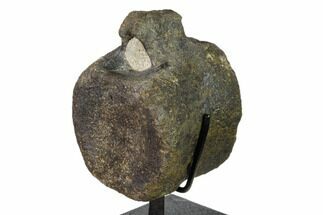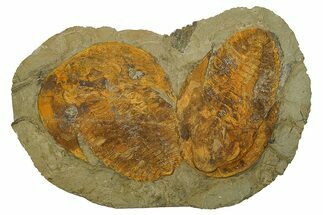This Specimen has been sold.
4.15" Dinosaur Caudal Vertebra on Metal Stand - Boulahfa, Morocco
This is a 4.15" long dinosaur caudal vertebra centrum, collected from the El Mers Group (El Mers I Formation) in the Middle Atlas Mountains near Boulahfa, Morocco. While there are multiple dinosaurs that have been described from this formation, providing an accurate identification to an isolated bone such as this is near impossible, especially considering no complete specimens have ever been excavated. It's even possible this bone is from a yet to be described dinosaur.
Comes with the pictured custom metal display stand. There is a repaired crack through the middle of the vertebra.
Comes with the pictured custom metal display stand. There is a repaired crack through the middle of the vertebra.
The El Mers Group is a group of geologic deposits with a stratigraphic range of approximately 164 to 168 million years (Bathonian to Callovian), located near Boulahfa, Morocco. It is divided into three formations know as El Mers I, II, and III. The El Mers III formation bears the youngest fossils (~164 million years). The group has produced a good amount of dinosaur material, including indeterminate theropod (Allosauridae indet. & Megalosauridae? indet.), sauropod (Cetiosaurus mogrebiensis), stegosaur (Adratiklit boulahfa), the ichnofossil "Selenichnites" (crescent-shaped impressions), indeterminate teleosauroid (Machimosauridae indet.) material, and a very interesting ankylosaur (Spicomellus afer) specimen.
The ankylosaur (Spicomellus afer gen. et sp. nov.) material found in this deposit appears to represent the earliest-known ankylosaur, and the first to be named from Africa. It would have lived during the time of the Laurasian and Gondwanan continents, split by an ocean called Tethys. Prior to the discovery of this unusual ankylosaur bone, ankylosauria were almost entirely restricted to Laurasian continents. This find filled an important gap in dinosaur evolution and suggests strongly that ankylosaurs had a global distribution.
The specimen is a T-shaped dorsal rib bone featuring multiple spikes along the dorsal surface. Strangely enough, the spikes are naturally fused to the rib, indicating more morphological diversity of armored dinosaurs during their early evolution than previously thought. This bizarre fusing is confusing, considering structures like that would seemingly hinder the growth and movement of muscles. Thanks to the discovery, continued excavation of this deposit will provide a better understanding of Spicomellus, and hopefully yield more interesting fossil discoveries.
The ankylosaur (Spicomellus afer gen. et sp. nov.) material found in this deposit appears to represent the earliest-known ankylosaur, and the first to be named from Africa. It would have lived during the time of the Laurasian and Gondwanan continents, split by an ocean called Tethys. Prior to the discovery of this unusual ankylosaur bone, ankylosauria were almost entirely restricted to Laurasian continents. This find filled an important gap in dinosaur evolution and suggests strongly that ankylosaurs had a global distribution.
The specimen is a T-shaped dorsal rib bone featuring multiple spikes along the dorsal surface. Strangely enough, the spikes are naturally fused to the rib, indicating more morphological diversity of armored dinosaurs during their early evolution than previously thought. This bizarre fusing is confusing, considering structures like that would seemingly hinder the growth and movement of muscles. Thanks to the discovery, continued excavation of this deposit will provide a better understanding of Spicomellus, and hopefully yield more interesting fossil discoveries.
SPECIES
Unidentified
LOCATION
Middle Atlas Mountains, Near Boulahfa, Morocco
FORMATION
El Mers Group (El Mers Formation I)
SIZE
Vertebra: 4.15 x 2.8 x 2.2", Height on stand: 6" tall
CATEGORY
SUB CATEGORY
ITEM
#252514
We guarantee the authenticity of all of our specimens.
 Reviews
Reviews












